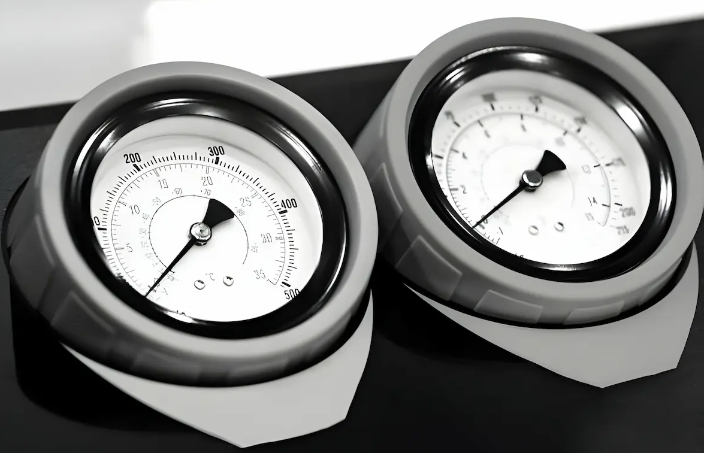Understanding Vacumetros
A vacumetros (or vacuum gauge) is a sensitive device utilized to measure the pressure in a vacuum (located between 0 and negative numbers on the psi scale). In HVAC it is an indispensable tool for diagnostic and operational purposes within refrigerant lines and the related components of an air conditioning system. By measuring the vacuum within these systems professionals can detect the presence of non-condensable gas system leaks and decontamination issues before they become hazardous or costly.
Types of Vacumetros
Vacumetros come in several types each serving specific purposes:
Bourdon Tube Gauges: Simple and reliable these gauges are somewhat less sensitive.
Digital Capacitance Manometers: Offering high precision they come with advanced features like data logging and readouts in various units.
Micron Gauges: Designed for accurate measurement of very low pressures crucial during the final stages of vacuuming an HVAC system.
Tee Adaptor-Style Gauges: Allow monitoring of the vacuum while the vacuum pump is still connected.
Why Are Vacumetros Important?
1. Ensuring System Efficiency: Proper vacuum levels are essential for optimal HVAC performance.
2. Maintaining Safety Standards: Detecting leaks and contamination prevents hazardous situations.
3. Cost Savings: Early detection avoids expensive repairs.
4. Applications of Vacumetros:
- HVAC System Maintenance
- Troubleshooting
- Calibration
The Introductory Story
Imagine a sweltering summer day. The air conditioner hums but the cool breeze remains elusive. The culprit? A tiny leak in the refrigerant line. Enter the unsung hero: the vacumetros. Like a detective, it silently measures the vacuum revealing the leak’s location. Our story begins here where precision meets practicality and HVAC systems breathe easy.
Different Types of Vacumetros
Let’s explore the various types of vacumetros and their unique features:
Mechanical Vacumetros:
- Renowned for their robustness and reliability in industrial environments.
- Examples include Bourdon tube gauges and diaphragm gauges.
- These gauges operate based on mechanical principles providing straightforward readings.
Thermal Vacumetros:
- Prized for their accuracy and versatility.
- Utilize thermal properties to measure vacuum levels.
- Common types include thermocouple gauges and Pirani gauges.
Ionization Vacumetros:
- Excel in measuring extremely low pressures down to the ultra-high vacuum range.
- Work by ionizing gas molecules in the vacuum detecting their conductivity.
- Widely used in scientific research and high-precision applications.
Capacitance Vacumetros:
- Employ changes in capacitance to determine vacuum pressure.
- Suitable for both rough and fine vacuum measurements.
- Often found in semiconductor manufacturing and vacuum systems.
Cold Cathode Vacumetros:
- Operate using electron emission from a cathode.
- Ideal for high-vacuum applications.
- Used in vacuum coating electron microscopy and space technology.
the choice of vacumetros depends on your specific needs accuracy requirements and budget. Whether you prefer analog or digital each type plays a crucial role in maintaining efficient systems. Happy exploring!
Common troubleshooting steps for faulty vacumetros
When it comes to troubleshooting faulty vacumetros HVAC professionals and homeowners can follow these steps to keep their systems running smoothly:
Regular Maintenance Checks:
Inspect the vacumetros regularly for physical damage loose connections or worn-out components.
Ensure the gauge is properly calibrated and zeroed before use.
Troubleshooting Common Issues:
Sudden Vacuum Changes: If you notice abrupt fluctuations in vacuum levels it could indicate a leak or blockage within the system. Check for damaged hoses fittings or valves.
Inaccurate Readings: If the gauge provides inconsistent or incorrect readings verify its calibration and ensure it’s not affected by external factors (e.g. temperature variations).
Clogged Lines: A clogged refrigerant line can impact vacuum readings. Inspect the lines for debris or obstructions.
Calibration for Accuracy:
Regularly calibrate the vacumetros using a reliable reference gauge.
Follow manufacturer guidelines for calibration intervals and procedures.
Tips for Extending Lifespan:
Store the gauge properly when not in use to prevent damage.
Avoid exposing it to extreme temperatures or humidity.
Use protective covers or cases to prevent accidental impacts.
Conclusion
In this article, we’ve demystified vacumetros exploring their types functions, and best practices. Whether you’re an HVAC pro or a curious homeowner remember: behind every well-functioning system lies the unassuming gauge that keeps it all in check. So next time you adjust your thermostat tip your hat to the trusty vacumetros
Remember the keyword “vacumetros” has been seamlessly woven into our tale ensuring SEO optimization and readability.







